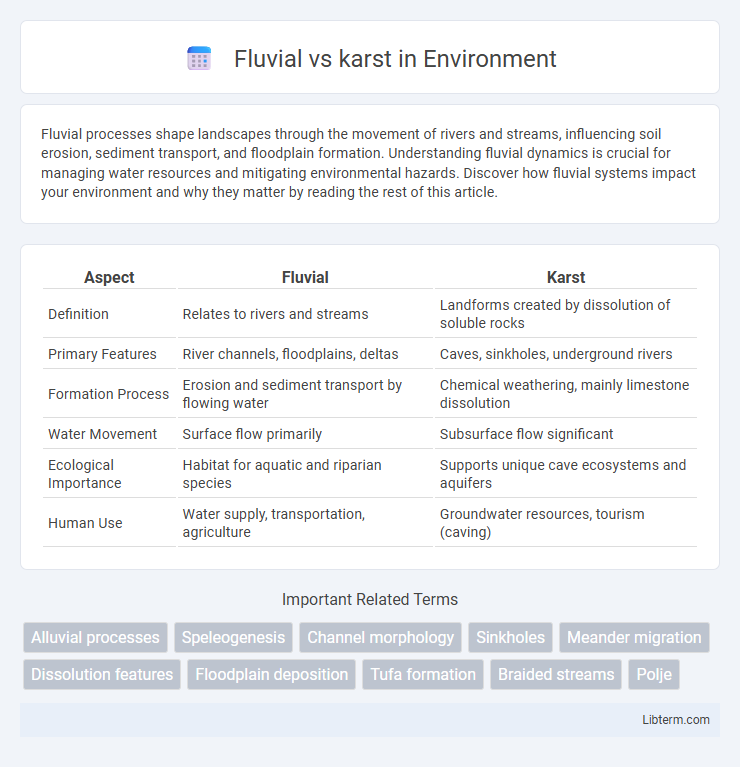Fluvial processes shape landscapes through the movement of rivers and streams, influencing soil erosion, sediment transport, and floodplain formation. Understanding fluvial dynamics is crucial for managing water resources and mitigating environmental hazards. Discover how fluvial systems impact your environment and why they matter by reading the rest of this article.
Table of Comparison
| Aspect | Fluvial | Karst |
|---|---|---|
| Definition | Relates to rivers and streams | Landforms created by dissolution of soluble rocks |
| Primary Features | River channels, floodplains, deltas | Caves, sinkholes, underground rivers |
| Formation Process | Erosion and sediment transport by flowing water | Chemical weathering, mainly limestone dissolution |
| Water Movement | Surface flow primarily | Subsurface flow significant |
| Ecological Importance | Habitat for aquatic and riparian species | Supports unique cave ecosystems and aquifers |
| Human Use | Water supply, transportation, agriculture | Groundwater resources, tourism (caving) |
Introduction to Fluvial and Karst Landscapes
Fluvial landscapes are shaped primarily by the action of rivers and streams, characterized by features such as valleys, floodplains, and deltas formed through erosion and sediment deposition. Karst landscapes develop in regions with soluble rocks, such as limestone, where chemical weathering creates caves, sinkholes, and underground drainage systems. These distinct geomorphological processes influence biodiversity, hydrology, and soil composition in their respective environments.
Defining Fluvial Processes
Fluvial processes refer to the movement and action of rivers and streams that shape the landscape through erosion, transportation, and deposition of sediments. These processes are driven by surface water flow, influencing river channel formation, floodplain development, and sedimentary patterns. Fluvial systems contrast with karst landscapes, which are primarily shaped by chemical dissolution of soluble rocks such as limestone.
Understanding Karst Processes
Karst processes involve the chemical weathering and dissolution of soluble rocks such as limestone, dolomite, and gypsum, leading to unique landforms including sinkholes, caves, and underground drainage systems. Unlike fluvial processes that primarily shape the landscape through surface water erosion and sediment transport, karst dynamics focus on subsurface hydrology where groundwater flow enlarges fractures and creates extensive cave networks. Understanding karst requires analyzing interactions between rock chemistry, water acidity, and flow patterns that drive speleogenesis and distinctive geomorphological features.
Geological Features of Fluvial Systems
Fluvial systems are characterized by the presence of rivers and streams that actively shape the landscape through processes of erosion, transportation, and deposition of sediments. These geological features include river channels, floodplains, alluvial fans, and terraces formed by sediment accumulation and water flow dynamics. The sediments in fluvial environments range from fine silts to coarse gravels, illustrating the energy variations within the river system.
Unique Landforms in Karst Regions
Karst regions are characterized by unique landforms such as sinkholes, caves, and underground rivers, formed primarily through the dissolution of soluble rocks like limestone. Fluvial landscapes, by contrast, develop through surface water erosion and deposition, shaping valleys, floodplains, and river terraces. The distinctive subsurface drainage systems and speleothems found in karst areas are absent in typical fluvial environments, highlighting the profound geomorphological differences between these two terrain types.
Hydrological Dynamics: Fluvial vs Karst
Fluvial hydrological dynamics are characterized by surface water movement through rivers and streams, with predictable flow patterns influenced by precipitation and terrain. Karst systems exhibit complex subsurface water flow through soluble rock formations, leading to rapid infiltration, underground drainage networks, and variable water table levels. The distinct contrast between fluvial's surface runoff and karst's subterranean channels significantly impacts groundwater recharge and flood behavior.
Erosion and Deposition Mechanisms
Fluvial erosion primarily involves the mechanical and chemical breakdown of rock and sediment through the flowing action of rivers and streams, with deposition occurring as water velocity decreases, forming features like alluvial fans and floodplains. Karst erosion is dominated by the chemical dissolution of soluble rocks such as limestone, creating distinctive landforms like sinkholes, caves, and underground drainage systems through the action of slightly acidic water. While fluvial processes shape landscapes by sediment transport and channel formation, karst processes fundamentally alter bedrock structure via solution and subsurface void development.
Ecological Impacts in Fluvial and Karst Environments
Fluvial environments support diverse aquatic habitats with nutrient-rich sediments promoting high biodiversity among fish and invertebrates, while karst systems harbor unique, specialized cave-dwelling organisms adapted to nutrient-poor, groundwater-dependent ecosystems. Alterations in fluvial flow regimes from damming or pollution disrupt sediment transport and spawning sites, causing declines in native species, whereas contamination or groundwater extraction in karst areas can degrade fragile subterranean habitats, threatening endemic and often rare species. Both environments face ecological challenges from human activities, but the hydrological connectivity in fluvial systems contrasts with isolated karst aquifers, influencing the scale and resilience of ecological impacts.
Human Interactions and Environmental Concerns
Fluvial systems, shaped by rivers and streams, significantly influence human settlements through water supply, agriculture, and transportation but face challenges like pollution, erosion, and habitat disruption. Karst landscapes, characterized by soluble rock formations such as limestone, pose unique concerns including groundwater contamination risks, land subsidence, and sinkhole formation impacting infrastructure and water quality. Effective management of both fluvial and karst environments requires integrated strategies prioritizing sustainable water use, pollution control, and protection of fragile ecosystems to mitigate adverse human and environmental impacts.
Comparative Analysis: Fluvial vs Karst Systems
Fluvial systems are characterized by river and stream processes that shape landscapes through erosion, transport, and deposition of sediments, forming valleys and floodplains. Karst systems develop primarily in soluble rock such as limestone, with features like sinkholes, caves, and underground drainage resulting from chemical weathering and dissolution. Comparative analysis reveals that while fluvial systems are driven by surface water flow and sediment dynamics, karst environments are dominated by subsurface hydrology and chemical interactions, influencing distinct geomorphological patterns and ecosystem habitats.
Fluvial Infographic

 libterm.com
libterm.com